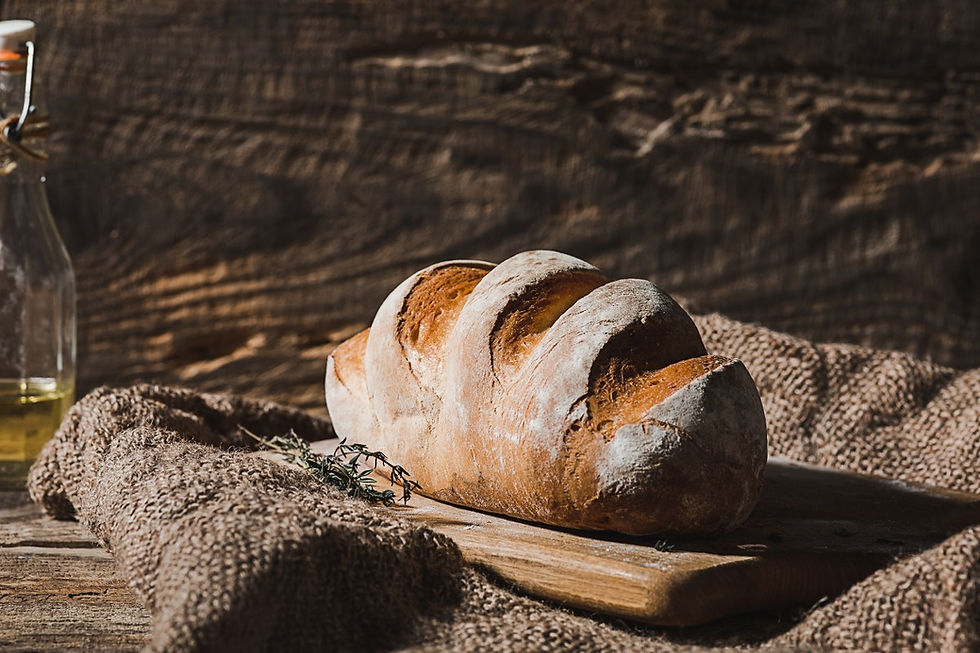Fermenting Flavor: The Allure of Sourdough Bread Artistry
- Şef İbrahim Dinç

- 30 Ara 2023
- 3 dakikada okunur
Sourdough bread has captivated food enthusiasts around the world, transcending its humble origins to become a culinary art form. The allure of sourdough lies not only in its distinctive tangy taste and chewy texture but also in the fascinating process of fermentation that transforms simple ingredients into a complex and flavorful loaf.
At its core, sourdough is a traditional bread-making method that predates commercial yeast. The magic begins with a mixture of flour and water left to ferment, allowing wild yeast and bacteria present in the environment to cultivate. This natural fermentation process imparts a unique character to the bread, creating a symbiotic relationship between the dough and the microorganisms that give sourdough its signature taste.
One of the key elements that make sourdough artisanal is the starter, a living culture of wild yeast and lactobacilli that serves as the leavening agent. Bakers often cultivate and nourish their starters for years, resulting in a distinctive blend of flavors that can’t be replicated with commercial yeast. This personal touch adds an extra layer of complexity to the art of sourdough bread-making.
The artistry of sourdough extends beyond the basic recipe. Bakers experiment with various types of flour, hydration levels, and fermentation times to tailor the bread to their preferences. The meticulous attention to detail, from the stretch-and-fold technique to the precise timing of each step, contributes to the development of a well-structured and flavorful loaf.
The beauty of sourdough lies not only in its taste but also in the diverse array of shapes and scoring patterns that bakers use to create visually stunning bread. From intricately scored boules to rustic batards, the aesthetic appeal of sourdough bread adds another layer to its allure. Bakers often share their creations on social media, creating a vibrant online community dedicated to the art of sourdough.
Beyond its culinary appeal, sourdough embodies a connection to tradition and the slow food movement. The patience required for fermentation and the reliance on natural processes harken back to a time when bread-making was an artisanal craft. In a fast-paced world, the slow and deliberate nature of sourdough bread-making provides a meditative and rewarding experience for those who embrace it.
In conclusion, the allure of sourdough bread artistry lies in the combination of flavors, textures, and the intricate process of fermentation. From the creation of a unique starter to the careful crafting of each loaf, sourdough represents a fusion of tradition and innovation in the world of bread-making. As enthusiasts continue to explore and share their creations, the art of sourdough remains a testament to the beauty of slow, intentional, and flavorful food.
Ingredients:
1 cup sourdough starter
1.5 cups warm water
4 cups all-purpose flour
1.5 teaspoons salt
Instructions:
Feed your sourdough starter: The night before, feed your sourdough starter. Take your starter in a bowl and add 1/2 cup of flour and 1/2 cup of warm water. Mix well, cover, and let it ferment at room temperature overnight.
Prepare the dough: In a large bowl, place 4 cups of flour. Make a well in the center and add the fed sourdough starter, warm water, and salt. Stir slowly and knead until you have a homogeneous dough.
First fermentation: Transfer the dough to a lightly floured surface. Sprinkle a bit of flour on top, cover with plastic wrap, and let it ferment at room temperature for about 4 hours. During this time, the dough should double in size.
Shape the dough: Transfer the fermented dough to a floured surface. Press down the dough slightly and fold it from the edges towards the center, creating a tight ball. Flip the dough and cover it. Let it rest for about 15-20 minutes.
Second fermentation: Place the shaped dough into a bread form or loaf pan, cover it, and let it ferment for another 2 hours at room temperature.
Baking: Preheat the oven to 230 degrees Celsius (450 Fahrenheit). Once the oven is hot, place the dough inside and bake for 30-40 minutes or until the top is nicely browned.
Cooling: Remove the bread from the oven and transfer it to a wire rack. Allow it to cool completely before slicing.
Enjoy your sourdough bread!




Yorumlar